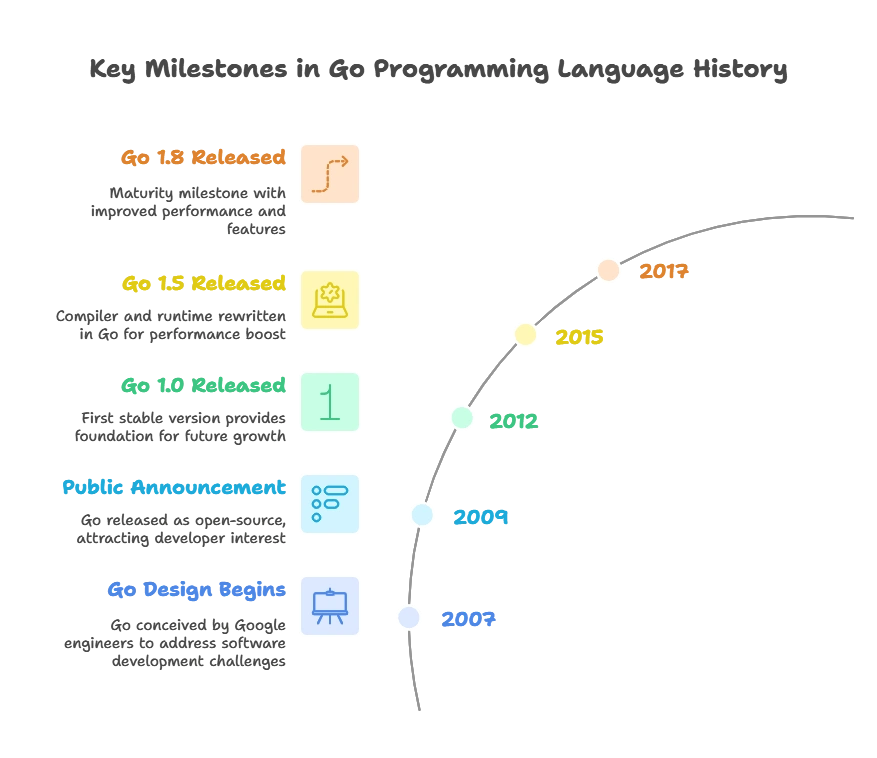What is Go ?
Go, also known as Golang, is a statically typed, compiled programming language designed by Google. It emphasizes simplicity, efficiency, and strong support for concurrent programming. Go was created to address the shortcomings of other programming languages used at Google, such as C++ and Java, particularly in terms of compilation speed, ease of use, and support for modern hardware architectures.
Origin and History
Go was conceived in 2007 by Robert Griesemer, Rob Pike, and Ken Thompson at Google. The initial goal was to create a language that could handle the scale of Google’s infrastructure while improving the efficiency of software development.
- 2007: The design of Go began, with the goal of addressing common criticisms of other programming languages.
- 2009: Go was publicly announced and released as an open-source project. The language attracted significant attention from the developer community due to its innovative features and the reputation of its creators.
- 2012: The first stable version, Go 1.0, was released, providing a stable foundation for future development.
- 2015: Go 1.5 was released, featuring a significant rewrite of the language’s compiler and runtime in Go itself, rather than C.
- 2017: The release of Go 1.8 marked the language’s maturity with improved performance and additional features.

Features
- Simplicity: Go’s syntax is clean and minimalistic, making it easy to learn and write. The language avoids many of the complexities found in other languages.
- Concurrency: Go provides robust support for concurrent programming through goroutines and channels. Goroutines are lightweight threads managed by the Go runtime, allowing efficient multitasking.
- Compiled Language: Go is a compiled language, which means it translates source code directly into machine code, resulting in fast execution times.
- Garbage Collection: Go includes an efficient garbage collector that automatically manages memory, reducing the likelihood of memory leaks and other memory-related issues.
- Static Typing: Go is statically typed, meaning variable types are explicitly declared and checked at compile time, reducing runtime errors.
- Standard Library: Go comes with a rich standard library that provides a wide range of functionalities, from file handling to web server creation, facilitating rapid development.
- Cross-Platform Compilation: Go supports cross-compilation, allowing developers to compile code for different operating systems and architectures from a single machine.
Advantages
- Performance: As a compiled language, Go offers high performance comparable to languages like C and C++.
- Concurrency: The built-in support for concurrency with goroutines and channels makes it easier to write programs that can efficiently utilize multicore processors.
- Ease of Use: Go’s simple syntax and straightforward design principles make it easy for new developers to learn and use effectively.
- Fast Compilation: Go’s compiler is designed for speed, enabling quick compilation times even for large codebases, which enhances the development experience.
- Robust Tooling: The Go ecosystem includes powerful tools for testing, benchmarking, and code formatting, improving the overall quality and maintainability of code.
- Strong Community: As an open-source project, Go has a vibrant community that contributes to its growth and provides extensive libraries and frameworks.
Drawbacks
- Limited Features: Go’s simplicity can be a double-edged sword; it lacks some features found in more complex languages, such as generics (although generics have been introduced in later versions), which can make certain tasks more cumbersome.
- Verbose Error Handling: Error handling in Go requires explicit checks and returns, leading to more verbose code compared to languages with exceptions.
- Manual Memory Management Limitations: While Go includes garbage collection, it doesn’t provide as fine-grained control over memory management as languages like C++.
- Library Maturity: Although Go has a robust standard library, some third-party libraries may not be as mature or comprehensive as those available for older languages.
- Learning Curve for Concurrency: While Go’s concurrency model is powerful, it can also be complex to master, particularly for developers who are new to concurrent programming.
Go has become a popular choice for a wide range of applications, from web development and cloud services to networking tools and system programming. Its combination of simplicity, performance, and robust concurrency support makes it an attractive option for modern software development. Happy coding !❤️
